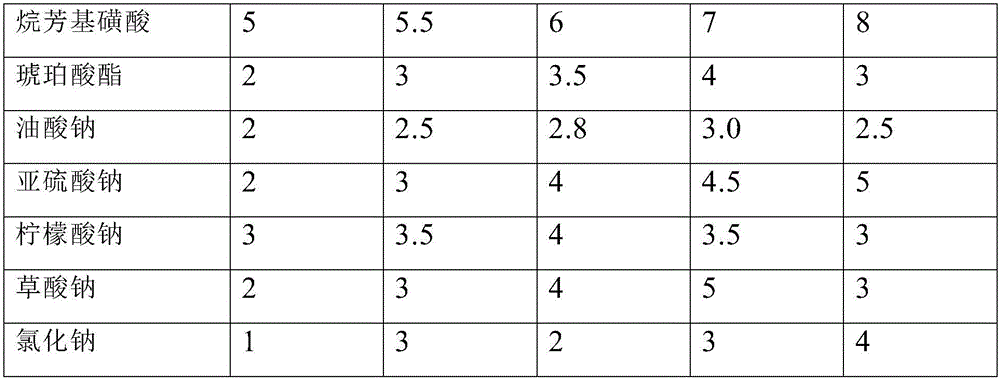Process for printing and dyeing wool fabric
A printing and dyeing process and fabric technology, applied in the field of wool fabric dyeing process, can solve the problems of low chromaticity, more waste water, large bath ratio, etc., and achieve the effects of reducing dyeing bath ratio, reducing dosage and improving color fastness.
- Summary
- Abstract
- Description
- Claims
- Application Information
AI Technical Summary
Problems solved by technology
Method used
Image
Examples
Embodiment 1
[0031] (1) Preparatory process: prepare woolen fabric with dyeing;
[0032] (2) Pre-treatment process: chlorination and dephosphorization of wool fabrics, bleaching with a concentration of 2.5% brightener, washing, reduction rinsing, washing, and drying;
[0033] (3) Ionic liquid treatment process: the pretreatment volume concentration of hydrophobic ionic liquid is 5%;
[0034] (4) Printing and dyeing process: Dye the wool fabric treated with ionic liquid, add sodium hydroxide 2g / L, sodium carbonate 8g / L, formaldehyde-free color fixing agent L 3g / L, leveling agent TF-210 3g / L , reactive dyes 0.5g / L are put into water in turn, after the fuel is dissolved at room temperature, the wool fabric is immersed in the dye solution, and then the printing and dyeing auxiliaries and acid release agent ammonium acetate are added, and the wool fabric is dipped in the dye solution for 30 minutes, bathed The ratio is 1:10, heat up to 50°C, add softener, keep warm for 30 minutes, adjust the p...
Embodiment 2
[0040] (1) Preparatory process: prepare woolen fabric with dyeing;
[0041] (2) Pre-treatment process: Chloride and dephosphorize wool fabrics, bleach with a concentration of 3% brightener, wash, reduce rinsing, wash, and dry;
[0042] (3) Ionic liquid treatment process: the pretreatment volume concentration of hydrophobic ionic liquid is 8%;
[0043] (4) Printing and dyeing process: Dye the wool fabric treated with ionic liquid, add sodium hydroxide 3g / L, sodium carbonate 10g / L, formaldehyde-free fixing agent L 4g / L, leveling agent TF-210 4g / L , reactive dyes 1g / L are put into water in turn, after the fuel is dissolved at room temperature, the wool fabric is immersed in the dye solution, and then the printing and dyeing auxiliaries and ammonium sulfate acid release agent are added. The wool fabric is dipped in the dye solution for 30 minutes, and the liquor ratio Heat up to 50°C at 1:15, add softener, keep warm for 35 minutes, adjust pH to 7.5, heat up to 75°C, keep warm for...
Embodiment 3
[0049] (1) Preparatory process: prepare woolen fabric with dyeing;
[0050] (2) Pre-treatment process: chlorination and dephosphorization of wool fabrics, bleaching with a concentration of 4% brightener, washing, reduction rinsing, washing, and drying;
[0051] (3) Ionic liquid treatment process: the pretreatment volume concentration of hydrophobic ionic liquid is 10%;
[0052] (4) Printing and dyeing process: Dye the wool fabric treated with ionic liquid, add sodium hydroxide 4g / L, sodium carbonate 16g / L, formaldehyde-free color fixing agent L 5g / L, leveling agent TF-210 5g / L , reactive dyes 1.5g / L are put into water in turn, after the fuel is dissolved at room temperature, the wool fabric is immersed in the dye solution, and then the printing and dyeing auxiliaries and ammonium sulfate acid release agent are added, and the wool fabric is dipped in the dye solution for 30 minutes, bathed Raise the temperature to 50°C with a ratio of 1:20, add softener, keep it warm for 40 mi...
PUM
 Login to View More
Login to View More Abstract
Description
Claims
Application Information
 Login to View More
Login to View More - Generate Ideas
- Intellectual Property
- Life Sciences
- Materials
- Tech Scout
- Unparalleled Data Quality
- Higher Quality Content
- 60% Fewer Hallucinations
Browse by: Latest US Patents, China's latest patents, Technical Efficacy Thesaurus, Application Domain, Technology Topic, Popular Technical Reports.
© 2025 PatSnap. All rights reserved.Legal|Privacy policy|Modern Slavery Act Transparency Statement|Sitemap|About US| Contact US: help@patsnap.com



